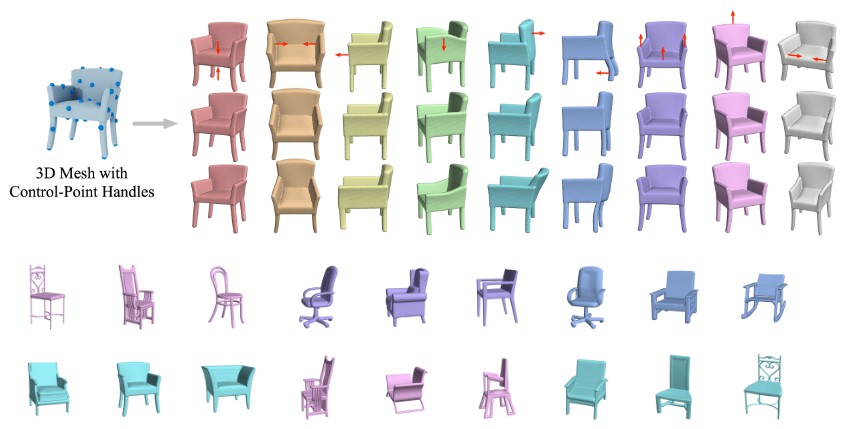DeepMetaHandles (CVPR2021 Oral)
DeepMetaHandles is a shape deformation technique. It learns a set of meta-handles for each given shape. The disentangled meta-handles factorize all the plausible deformations of the shape, while each of them corresponds to an intuitive deformation direction. A new deformation can then be generated by the "linear combination" of the meta-handles. Although the approach is learned in an unsupervised manner, the learned meta-handles possess strong interpretability and consistency.

Environment setup
- Create a conda environment by
conda env create -f environment.yml. - Build and install torch-batch-svd.
Demo
- Download
data/demoandcheckpoints/chair_15.pthfrom here and place them in the corresponding folder. Pre-processed demo data contains the manifold mesh, sampled control point, sampled surface point cloud, and corresponding biharmonic coordinates. - Run
src/demo_target_driven_deform.pyto deform a source shape to match a target shape. - Run
src/demo_meta_handle.pyto generate deformations along the direction of each learned meta-handle.
Train
- Download
data/chairfrom here and place them in the corresponding folder. - Run the visdom server. (We use visdom to visualize the training process.)
- Run
src/train.pyto start training.
Note: For different categories, you may need to adjust the number of meta-handles. Also, you need to tune the weights for the loss functions. Different sets of weights may produce significantly different results.
Pre-process your own data
- Compile codes in
data_preprocessing/. - Build and run manifold to convert your meshes into watertight manifolds.
- Run
data_preprocessing/normalize_binto normalize the manifold into a unit bounding sphere. - Build and run fTetWild to convert your manifolds into tetrahedral meshes. Please use
--output xxx.meshoption to generate the.meshformat tet mesh. Also, you will get axxx.mesh__sf.objfor the surface mesh. We will usexxx.meshandxxx.mesh__sf.objto calculate the biharmonic weights. We will only deformxxx.mesh__sf.objlater. - Run
data_preprocessing/sample_key_points_binto sample control points fromxxx.mesh__sf.obj. We use the FPS algorithm over edge distances to sample the control points. - Run
data_preprocessing/calc_weight_binto calculate the bihrnomic weights. It takesxxx.mesh,xxx.mesh__sf.obj, and the control point file as input, and will output a text file containing the weight matrix for the vertices inxxx.mesh__sf.obj. - Run
data_preprocessing/sample_surface_points_binto sample points on thexxx.mesh__sf.objand calculate the corresponding biharmonic weights for the sampled point cloud. - In our training, we remove those shapes (about 10%) whose biharmonic weight matrix contains elements that are smaller than -1.5 or greater than 1.5. We find that this can help us to converge faster.
- To reduce IO time during training, you may compress the data into a compact form and load them to the memory.
Citation
If you find our work useful, please consider citing our paper:
@article{liu2021deepmetahandles,
title={DeepMetaHandles: Learning Deformation Meta-Handles of 3D Meshes with Biharmonic Coordinates},
author={Liu, Minghua and Sung, Minhyuk and Mech, Radomir and Su, Hao},
journal={arXiv preprint arXiv:2102.09105},
year={2021}
}



